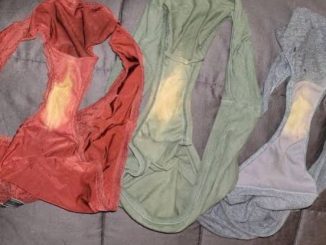
This year’s Olympics are now in full swing and it’s all eyes on the athletes.
From archery and shooting to athletics and gymnastics, there’s all kind of sports taking place across Paris, France, at the moment.
One fan-favorite sport to watch is the swimming, and this year there’s a whopping 854 athletes from 187 different countries competing.
But there’s a common theme you might have spotted with some of the swimmers and that’s the unusual dark red circles they have on their backs.

While it might look like they’ve had a fight with an octopus and lost, there’s a very different reason for the odd markings.
It turns out that the large spots are from cupping therapy – an ancient healing technique that involves placing cups on the skin to create suction and increase blood flow to the area.
The unconventional method is supposed to help with muscle recovery and is used as a type of deep tissue massage.
Some athletes were spotted with cupping therapy bruises back at the Rio Olympics in 2016, and it’s still seemingly popular now.

Gymnast Alexander Naddour told USA Today back in 2016 that cupping was supposedly the ‘secret’ to his health.
He added: “It’s been better than any money I’ve spent on anything else.”
Away from the Games, basketball player Kyle Singler has also praised cupping therapy.
“The bruises do look more intense than what they actually feel like, but the benefit from it is really great,” he previously insisted.
Singler continued to tell Sports Illustrated: “You’re not necessarily getting the immediate response that you might want but over time it does help with recovery and loosening tissue and stuff like that.”
But does cupping therapy actually work according to experts? It’s seems as if the jury’s still out.

According to Harvard Health, some studies have found that cupping might provide some relief for a number of musculoskeletal and sports-related conditions. The quality of this evidence was ‘limited’, however.
Elsewhere a 2022 review found that wet (as opposed to dry cupping) was effective for lower back pain.
While the bruises people get from cupping are pretty gnarly, the therapy is generally seen as safe to practice – even if people aren’t 100 percent on how affective it is.
“Most experts agree that cupping is safe. As long as those treated don’t mind the circular discolorations (which fade over a number of days or weeks), side effects tend to be limited to the pinch experienced during skin suction,” Harvard Health explains.
“It’s quite unusual that cupping causes any serious problems (though, rarely, skin infections have been reported).”
There you have it, folks.
I Discovered My Husband Mocks Me in Front of His Friends & I Taught Him a Lesson He’ll Never Forget

I’m a full-time mom. About a year ago, I left my job to take care of our three-year-old daughter, who is autistic and requires a lot of support. Lately, I’ve noticed that my usually feminist husband has been criticizing me in a group chat.
Transitioning into the role of a stay-at-home mom (SAHM) wasn’t something I had envisioned for myself. I used to thrive in the fast-paced world of marketing, surrounded by campaigns and fueled by brainstorming sessions over coffee. But all that changed a little over a year ago when my husband, Jake, and I made a significant decision. Our daughter, Lily, who is three and autistic, needed more attention than what her daycare could provide. Her needs are complex, requiring constant care and support, and it became clear that one of us had to be with her full-time.
I won’t sugarcoat it — leaving my career behind was one of the toughest decisions I’ve ever made. I miss the freedom of earning my own income and the satisfaction of a job well done. But here I am now, spending my days planning meals, cooking, and baking. I’ve found joy in these tasks, and experimenting in the kitchen has become my new creative outlet.
Our backyard has turned into a small garden oasis under my care, and I take care of most of the household chores. Jake does his fair share too; he’s actively involved in chores and parenting whenever he’s at home. We’ve always considered ourselves equals, rejecting traditional gender roles, or so I thought until last week.
It was a regular Thursday, and I was tidying up Jake’s home office while he was at work. It’s filled with tech gadgets and piles of paperwork, typical for someone in software development. His computer screen caught my eye — it was still on, casting a soft glow in the dim room. He usually left it on by accident, but what I saw next wasn’t accidental at all.
His Twitter feed was open, and I froze when I saw the hashtag #tradwife attached to a tweet. Confusion washed over me as I read the post. It glorified the joys of having a traditional wife who embraces her domestic duties. Attached was a photo of me, taking a batch of cookies out of the oven, looking every bit like a 1950s housewife. My stomach churned as I scrolled through more posts. There I was again, tending to the garden and reading to Lily, our faces thankfully obscured.
This was Jake’s account, and he had been crafting a whole narrative about our life that was far from reality. He portrayed me as a woman who relished her role as a homemaker, willingly sacrificing her career for aprons and storybooks. The truth of our situation — that this arrangement was a necessity for our daughter’s well-being — was nowhere to be seen.
I felt betrayed. Here was the man I’d loved and trusted for over a decade, sharing our life with strangers under a false pretense that felt foreign to me. It wasn’t just the lies about our relationship dynamics that hurt — it was also the realization that he was using these glimpses of our life to bolster some online persona.
I shut the computer down, my hands trembling with a mix of anger and bewilderment. All day, I grappled with my emotions, trying to comprehend why Jake would do this. Was he dissatisfied with our situation? Did he resent my decision to stay home? Or was it something deeper, a shift in how he perceived me now that I wasn’t contributing financially?
The rest of the day passed in a blur. His posts kept replaying in my mind, and eventually, I couldn’t ignore them any longer. I decided to call him and address everything head-on.
“Jake, we need to talk,” I finally said, trying to keep my voice steady.
He answered, sounding concerned. “What’s wrong?”
I took a deep breath, the weight of my discovery weighing heavily on me. “I saw your Twitter today…”
His expression fell, and he let out a long sigh, indicating he knew exactly what this conversation was about to entail. He started to respond, but I interrupted him.
“Calm down,” he said, dismissing it as “just harmless posting.” That was the final straw. I told him I wanted a divorce, called him out for his deceit, and ended the call.
Jake rushed home immediately. We argued, but with Lily’s strict schedule, I couldn’t let the conflict drag on. He pleaded with me to have a proper conversation after putting Lily to bed. Reluctantly, I agreed. That night, he showed me his phone, revealing that he had deleted the Twitter account. But the damage was already done.
A week passed, and my anger hadn’t subsided. This wasn’t a simple misunderstanding. It was a breach of trust. Jake attempted to explain, claiming it started as a joke, but he got carried away with the attention it garnered. But excuses weren’t enough.
Motivated by a mix of hurt and the need for justice, I decided to expose him. I took screenshots of his tweets and shared them on my Facebook page. I wanted our friends and family to know the truth. My post was straightforward: “Your husband belittles you in front of his friends behind your back. Sound familiar?”
The response was immediate. Our relatives were shocked, and the comments poured in. Jake was inundated with messages and calls. He left work early once more to beg for my forgiveness. He knelt, tears in his eyes, pleading that it was all just a “silly game.”
But I couldn’t let it go. The trust that bound us together was broken. It wasn’t just about a few misguided posts; it was about the respect and understanding we were supposed to have for each other. I told him I needed time and space to think and heal. I moved out with Lily to another apartment.
For six months, Jake begged for forgiveness. He sent messages, left voicemails, and made small gestures to show he was sorry. But sorry wasn’t enough. I told him that if he truly wanted to make amends, we needed to start anew. In my eyes, we were strangers now, and he had to court me like he did years ago when we first met.
So, we began again, slowly. We went on dates, starting with coffee and progressing to dinners. We talked a lot — about everything except the past. It was like rediscovering ourselves individually and as a couple. Jake was patient, perhaps realizing this was his last chance to salvage our once-loving relationship.
As I sit here now, reflecting on the past year, I realize how much I’ve changed. This betrayal forced me to reevaluate not only my marriage but also myself and my needs. I’ve learned that forgiveness isn’t just about accepting an apology; it’s about feeling secure and valued again. It’s a gradual process, one that we’re both committed to, step by step.
What would you have done if you were in my shoes? Share your thoughts on Facebook.



Leave a Reply